投稿时间:2020-05-11
修订日期:2020-06-02
网络发布日期:2020-09-09
中文摘要:锂铍金属是国家战略关键金属资源,花岗岩-伟晶岩型是锂铍矿床的重要类型,是锂铍矿找矿的重要目标体,遥感是寻找与发现花岗岩与伟晶岩的有效方法。但是,对于花岗岩体中的伟晶岩,由于其与花岗岩在光谱信息差异微小而不易识别。为了解决此问题,文章选择东疆戈壁覆盖的镜儿泉花岗岩开展锂铍伟晶岩的遥感识别研究,采用的数据与方法包括:谷歌地球/奥维等遥感图片的分析、WORLDVIEW遥感的增强处理与ASTER遥感的岩性识别与提取,结果显示谷歌地球/奥维遥感图片与WORLDVIEW遥感图片对镜儿泉花岗岩中伟晶岩脉的识别效果不好。为了识别锂铍伟晶岩,文章采用了一种岩性微弱信号增强技术对ASTER遥感数据进行识别,经过处理后的图像可以清楚地识别出伟晶岩脉体、并于野外查证时发现了一处新的锂铍伟晶岩脉体。结果表明利用岩性微弱信号增强技术进行岩性识别是花岗岩中锂铍伟晶岩找矿一种新的有效方法。
Abstract:Lithium (Li) and beryllium (Be) are key metal resources of national strategy. The granitic-pegmatitic Li-Be deposits are an important type of Li-Be deposits and target for exploration of Li-Be resources. Remote sensing (RS) image might be used as an indicator to recognize the granite-pegmatite. However, it is difficult to identify the pegmatite in granite pluton because of the insignicant difference of spectral information between the pegmatite and the granite. To solve this problem, the authors applied the RS data to identifying the Li-Be pegmatite in Jingerquan area, the east Gobi of Xinjiang. The RS data and methods include image interpretation of Google Earth or Orville RS, enhanced image of Worldview RS data, uncovering the anomalies, and remote sensing lithologic enhancement (RSLE) identification of ASTER data. The results indicate that only using Google Earth, Orville or Worldview RS images is not effective in identifying the pegmatite veins in the Jingerquan granite. Compared with ASTER, RSLE is more effective in distinguishing the Li-Be pegmatite veins.
文章编号:
中图分类号:
文献标志码:
基金项目:本文得到科研院所基本业务费专项经费资助项目(编号:K1501)和地质调查项目(编号:DD20190193)联合资助
引用文本:
姚佛军,徐兴旺,杨建民,吴林楠,耿新霞.2020.戈壁浅覆盖区花岗岩中锂铍伟晶岩的ASTER遥感识别技术——以新疆镜儿泉地区为例[J].矿床地质,39(4):686~696YAO FoJun,XU XingWang,YANG JianMin,WU LinNan,GENG XinXia.2020.A technology for identifying Li-Be pegmatite using ASTER remote sensing data in granite of Gobi shallow-covered area: A case study of recognition and prediction of Li-Be pegmatite in Jingerquan, Xinjiang[J].Mineral Deposits39(4):686~696
图/表

